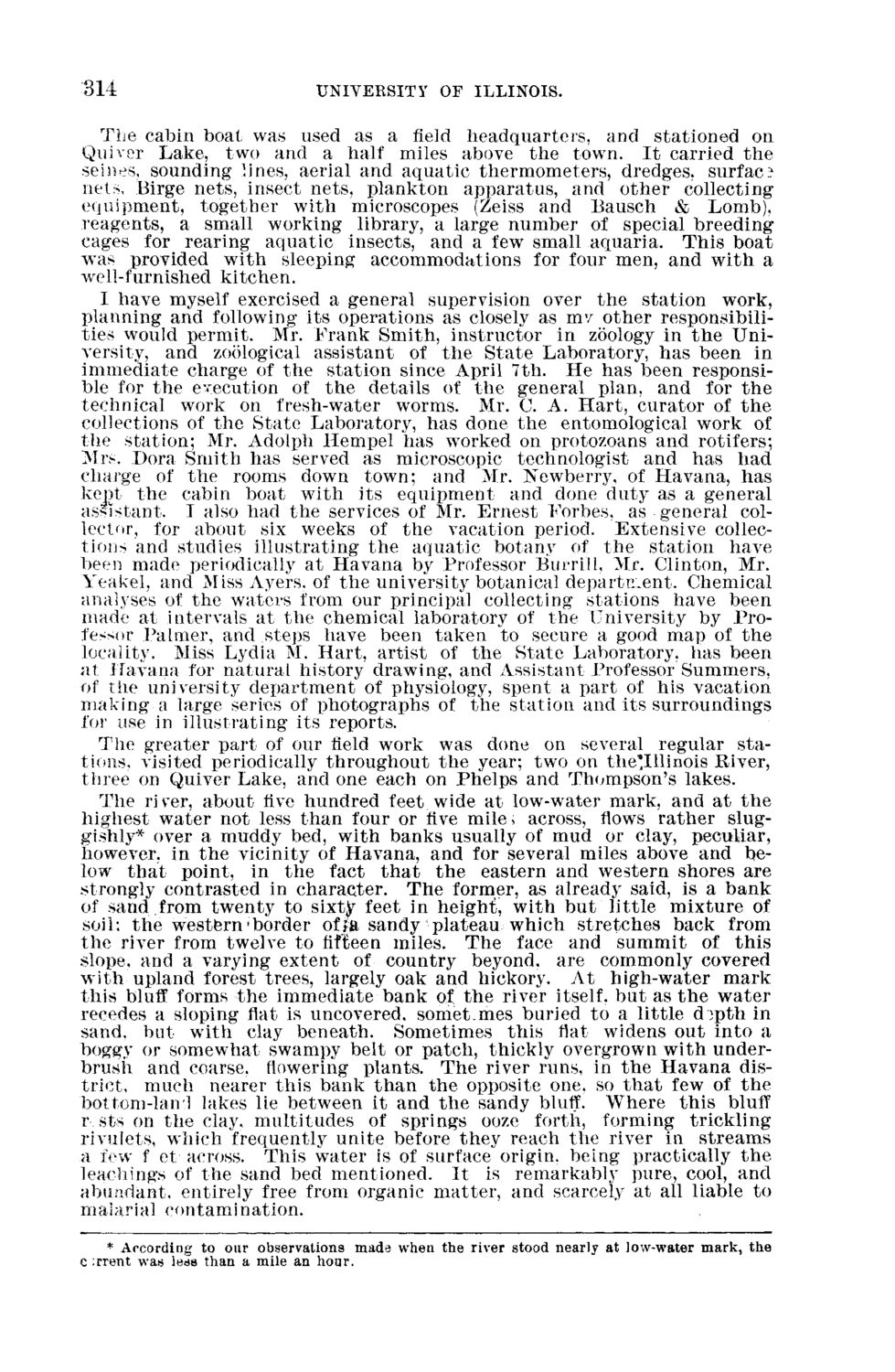| |
| |
Caption: Board of Trustees Minutes - 1894
This is a reduced-resolution page image for fast online browsing.

EXTRACTED TEXT FROM PAGE:
314 UNIVERSITY OF I L L I N O I S . The cabin boat was used as a field headquarters, and stationed on Quiver Lake, two and a half miles above the town. I t carried the seines, sounding lines, aerial and aquatic thermometers, dredges, surfac? nets, Birge nets, insect nets, plankton apparatus, and other collecting equipment, together with microscopes (Zeiss and Bausch & Lomb), reagents, a small working library, a large number of special breeding cages for rearing aquatic insects, and a few small aquaria. This boat was provided with sleeping accommodations for four men, and with a well-furnished kitchen. I have myself exercised a general supervision over the station work, planning and following its operations as closely as mv other responsibilities would permit. Mr. Frank Smith, instructor in zoology in t h e University, and zoological assistant of the State Laboratory, has been in immediate charge of the station since April 7th. He has been responsible for the execution of the details of the general plan, and for t h e technical work on fresh-water worms. Mr. C. A. Hart, curator of t h e collections of the State Laboratory, has done the entomological work of the station; Mr. Adolph Hempel has worked on protozoans and rotifers; Mrs. Dora Smith has served as microscopic technologist and has had charge of the rooms down town; and Mr. Newberry, of Havana, has kejjt the cabin boat with its equipment and done duty as a general assistant. I also had the services of Mr. Ernest Forbes, as general collector, for about six weeks of the vacation period. Extensive collections and studies illustrating the aquatic botany of the station have been made periodically at Havana by Professor Burrill, Mr. Clinton, Mr. Yeakel, and Miss Ayers, of t h e university botanical department. Chemical analyses of the waters from our principal collecting stations have been made at intervals at the chemical laboratory of the University by Professor Palmer, and steps have been taken to secure a good map of the locality. Miss Lydia M. Hart, artist of the State Laboratory, has been at Havana for natural history drawing, and Assistant Professor Summers, of the university department of physiology, spent a part of his vacation making a large series of photographs of the station and its surroundings for use in illustrating its reports. The greater part of our field work was done on several regular stations, visited periodically throughout the year; two on the*Illinois River, three on Quiver Lake, and one each on Phelps and Thompson's lakes. The river, about five hundred feet wide at low-water mark, and at t h e highest water not less than four or five mile, across, flows rather sluggishly* over a muddy bed, with banks usually of mud or clay, peculiar, however, in the vicinity of Havana, and for several miles above and below t h a t point, in the fact t h a t the eastern and western shores are strongly contrasted in character. The former, as already said, is a bank of sand from twenty to sixty feet in height, with but little mixture of soil: the western'border of la sandy plateau which stretches back from the river from twelve to fifteen miles. The face and summit of this slope, and a varying extent of country beyond, are commonly covered with upland forest trees, largely oak and hickory. At high-water mark this bluff forms t h e immediate bank of the river itself, but as t h e water recedes a sloping flat is uncovered. someUmes buried to a little d }pth in sand, but with clay beneath. Sometimes this flat widens out into a boggy or somewhat swampy belt or patch, thickly overgrown with underbrush and coarse, flowering plants. The river runs, in t h e Havana district, much nearer this bank t h a n the opposite one. so t h a t few of the bottom-Ian 1 lakes lie between it and t h e sandy bluff. Where this bluff r sts on the clay, multitudes of springs ooze forth, forming trickling rivulets, which frequently unite before they reach the river in streams a few f et across. This water is of surface origin, being practically t h e leachings of the sand bed mentioned. I t is remarkably pure, cool, and abundant, entirely free from organic matter, and scarcely at all liable to malarial contamination. * According to our observations made when the river stood nearly at ]ow-water mark, the c :rrent was leas than a mile an hour.
| |